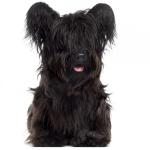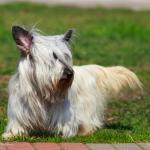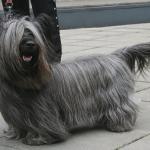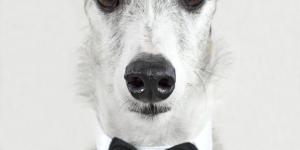Skye terrier
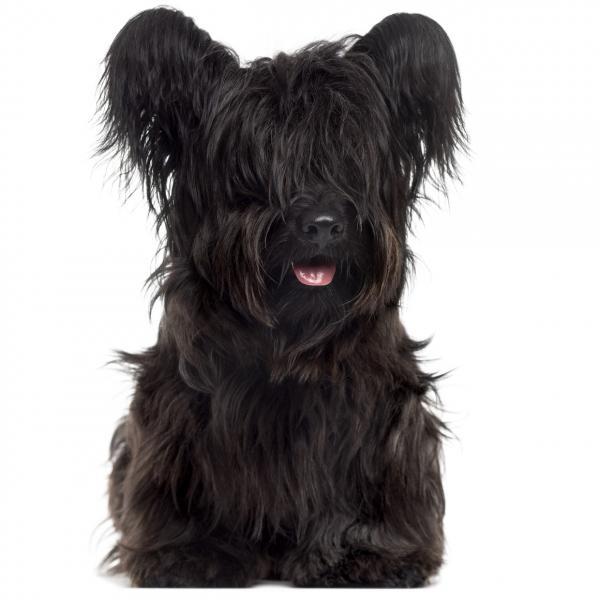
The Skye terrier is a very striking dog. They're small, with an elongated body and a lush, long coat. This dog is one of the least common of terriers and undoubtedly one of the most elegant breeds of dog. Their most notable feature are their long ears covered in long smooth straight hair. In the past, these dogs were used to hunt burrowing animals. However, nowadays this practice has been deprecated. Instead, many families are adopting Skye terriers as house pets. They are ideal for small apartments, as they require low physical activity. This may also be why they make great companions for the elderly. These dogs need a loyal companion as they can become aggressive or suffer from separation anxiety when separated from their companions.
If you're thinking of adopting a Skype terrier, keep reading this AnimalWised breed file to learn everything you need to know about this breed.
- Europe
- United Kingdom
- Group III
- 5-14
- 14-18
- 18-22
- 22-27
- 27-31
- More than 31
- 2-7
- 7-22
- 22-55
- 55-100
- 100-220
- 8-10
- 10-12
- 12-14
- 15-20
- Low
- Meidum
- High
Origin
This breed seems to be one of the oldest of all terrier breeds as these dogs were already described in the 16th century. Bred to hunt burrowing animals, the Skye terrier is compared to the Afghan Hound among the most attractive and stylish hunting dogs. The name of this breed derives from its place of origin, the Isle of Skye near the Scottish coast.
In 1840 the breed gained popularity among the UK aristocracy, due to Queen Victoria's fondness for these dogs. This popularity, however, did not exceed the passage of time. Today, this breed is one of the least popular.
Physical Appearance
According to this breed's FCI, the ideal height at the withers for males is 9,8 - 10,2 inches. The ideal length for males, form the tip of their nose to the tip of their tail, is 40,5 inches. Females are slightly smaller, but they maintain the same proportions.
The breed's FCI standard does not indicate an ideal weight, but Skye terriers are usually around 24,5 lbs. Males are slightly heavier than females. This dog's body is low and elongated. According to the breed standard, they must be twice as long as it is height, giving it a particular morphology. Their deep chest and body length could correspond to a high-rise dog, and contrast nicely with their short but muscular legs.
Their head is long and moderately broad. Their strongly marked and symmetrical muzzle ends with their black nose. Their eyes are medium sized, dark colored and very expressive. Their ears can be erect or hanging, whatever the case, they are always covered with abundant long hair.
The Skye terrier's tail is covered in abundant fringes, giving them an elegant appearance that harmonizes with the rest of the body. When the dog is active they lift their tail, but never higher than horizontal.
The Skye terrier's hair is perhaps one of their most notable characteristics and the one that gives the breed its elegant look. Their double coat formed by an inner layer of short, thick, soft and woolly hair, and an outer layer of long, hard, straight and flattened hair. Their coat can be black, gray, tawny or cream, with dark markings.
Personality
The elegant and graceful appearance of these dogs tends to hide their true tenacious and brave character. Skye terriers are very loyal and affectionate dogs, but they tend to be more affectionate with a single person. This is the reason why they are considered "dogs of a single companion".
It is very important to start socializing these dogs from an early age because as adults they tend to be reserved with strangers and can even be aggressive when not properly trained. With other dogs and with other pets they tend to be aggressive, this may be due to territoriality, social hierarchy, competition or predation. When well socialized, Skye terriers can welcome familiar people and dogs. Nevertheless, they will never be the friendliest of dogs towards strangers.
These dogs need a lot of company and it is not enough to see them from time to time. They cannot cope being in solitude for long periods of time. They need to be with their family and companion as long as possible.
These dogs can make excellent pets for elderly people or for young adults without children. Owners must have plenty of time to be with their pets as Skye terriers tend to suffer from separation anxiety. These dogs are not good pets for families with children, because they tend to bite when disturbed or threatened.
Care
The hair of these terriers does not require special care, but it takes more time than other breeds. Their hair must be brushed three or four times a weeks so it doesn't get tangled. This will also help reduce the amount of hair on furniture and clothing, as this breed loses hair regularly. Sky terriers don't need to be bathed very frequently, only when they get dirty.
This breed doesn't need a lot of exercise. One or two moderate walks every day is enough to keep them in shape. What they do need, however, is constant and consistent company. Do not leave them alone for a long time.
Due to their small size and reduced demand for exercise, these dogs can live well in a small apartment. In addition, unlike other terriers, their calm character makes them ideal for city life. They can also benefit from a garden where they can play and run freely, but they must live inside the house with the rest of the family.
Training and Education
In addition to correct socialization, it is important to follow a good training program in order to control the dogs and maintain a harmonious coexistence. Ideally, a canine obedience program that focuses on essential commands for a pet and not just competitive exercises. The training must be carried out with positive reinforcement, since these dogs are very sensitive to punishment and do not bear well the traditional methods based on the correction of bad behaviors through punishment. No animal can thrive on a training based on violence.
This breed may present behavior issues by being aggressive and suffering from separation anxiety. However, both of these problems can be managed by proper socialization and training through positive reinforcement.
Health Care
Sky terriers are a relatively healthy breed. Nevertheless, they do have some characteristic health issues. Some of these problems have to do with the particular morphology of Skye terriers, while others are common to various breeds of dogs. These include:
- Spinal problems
- Limb bone deformations
- Arthritis
- Cancer
- Autoimmune diseases
- Allergies
- Thyroid gland dysfunctions
It's advisable to go to the veterinarian every 6 months to prevent and detect any health issue that may arise. Following their vaccination schedule is also crucial to maintaining a healthy Skye terrier.
Skye terrier photos
